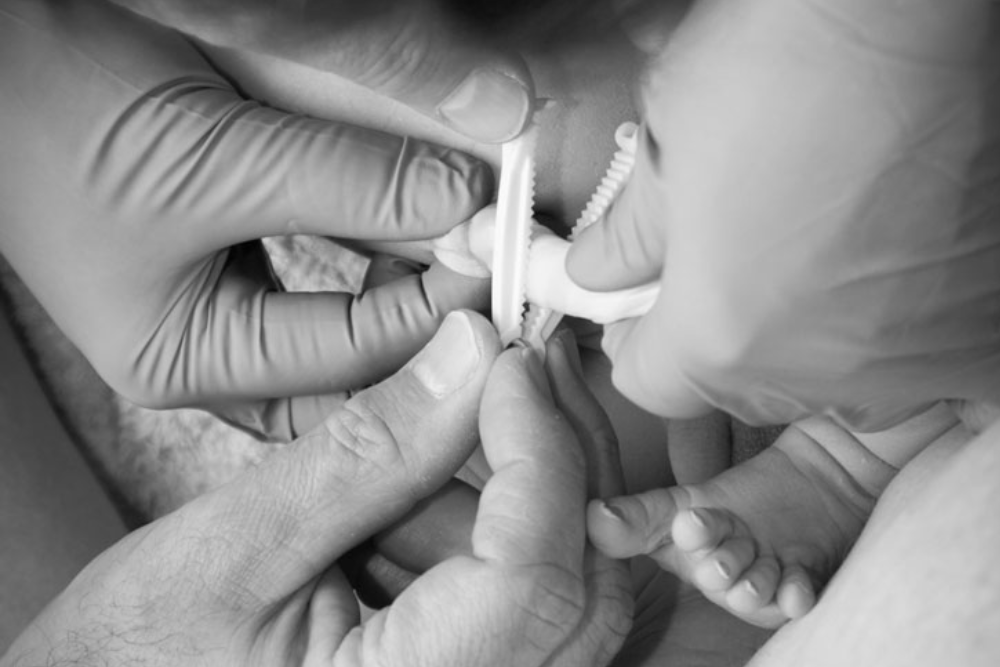
Umbilical cords are amazing. From the moment it forms and until it is cut, the umbilical cord supplies a baby with the oxygen and nutrients it requires for survival. The umbilical cord is comprised of one vein and two arteries enclosed in a sticky substance called Wharton’s Jelly. This is in turn encased in a membrane referred to as the amnion. After your baby is born the umbilical cord is no longer required and so the cord is cut with the area which remains carefully maintained until it heals. This is often referred to as cord care in newborns.
Cutting the Cord
An umbilical cord is approximately 50 centimetres long and runs from an opening in the baby’s stomach (where their navel will be) to the placenta. Once your baby has been born the umbilical cord is clamped using two plastic clips, one close to the baby’s belly button and the other a little further along the umbilical cord. The cord is then cut between these two clips. This leaves a piece of the umbilical cord around two or three centimetres long attached to your baby’s belly button, and the task of cord care in newborns begins!
As the Cord Dries
As soon as the umbilical cord is cut the piece left behind, often referred to as the ‘stump,’ begins to dry, shrivel and darken in colour. It is also common to see some clear, sticky or brownish oozing around the navel. While this might look concerning it is actually a normal part of the healing process. Within five to 15 days the stump of the umbilical cord will fall off.
During this time you will need to keep the area around your baby’s navel clean and dry. It is important not to try to hasten the cord falling off by pulling on, cutting or fiddling with it. While there are no nerves in an umbilical and cutting it at birth does not hurt your baby, pulling the piece left attached to your baby can cause bleeding and pain.
Cord Care in the Past
Over the years there have been many theories on the best practices for cord care in newborns. These have included applying rubbing alcohol as often as every nappy change, using iodine to clean the area or applying topical creams which contain antibacterial agents.
The object of all these methods has been to reduce the chance of infection and to speed up the drying process so the stump falls off sooner. However, the reality is that there is little in the way of conclusive evidence that any of these strategies actually achieve either of these objectives. In fact, some slow the time taken for the area to heal
Cleaning your Baby’s Navel
The most effective method for cord care in newborns is to simply clean the area gently daily and to allow plenty of air to reach it. Avoid trying to clean your baby’s navel while they are in the bath. Instead, once your baby’s bath is overlay them on their back on a towel and gently dry their body avoiding the navel area. Using cotton buds dipped in water, gently clean around the navel area. Dry cotton buds can then be used to gently dry around the cord stump. Once your baby’s cord stump falls off you will need to continue cleaning the area until the navel heals fully. Use the same method as before, cleaning and drying gently with cotton buds.
When you put on your baby’s nappy keep the nappy under and away from the navel. Apart from helping to ensure air reaches the area, this also helps to avoid urine or faeces from your baby’s nappy coming in contact with their healing navel. If this does occur you will need to clean the cord area using the same method described above. If you are cleaning away faeces you may need a little very mild soap in the water you use. Baby faeces contain a high percentage of fatty deposits and can be difficult to clean off with water alone.
When to Seek Help
In most cases, the stump of the umbilical will dry and fall off without event. However, sometimes an infection can develop. Each time you clean your baby’s navel look at it carefully for signs of infection. These include redness or swelling, a foul odour coming from the area, or oozing at the site after the stump has fallen off. These symptoms might be accompanied by your baby’s tummy feeling very hot or them running a fever. These symptoms may indicate that your baby has developed an infection in their naval area which requires treatment, so a trip to your doctor or midwife is a good idea.
Written 19 March 2014
References
Raising Children Network. (n.d.). Umbilical care. Retrieved from http://raisingchildren.net.au/articles/umbilical_care.html/context/295
NHS Choices. (n.d.). What is the umbilical cord? – Health questions – NHS Choices. Retrieved from http://www.nhs.uk/chq/pages/2299.aspx?categoryid=54
McConnell, T. P., Lee, C. W., Couillard, M., & Sherrill, W. W. (2004). Trends in umbilical cord care: Scientific evidence for practice. Newborn and Infant Nursing Reviews, 4(4), 211–222. doi:10.1053/j.nainr.2004.09.004
Revised on 30th November 2021


Recent Comments